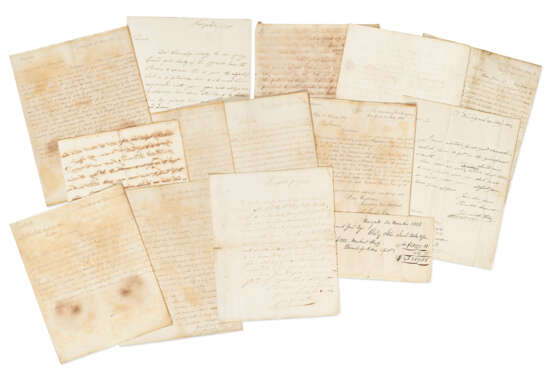ID 1236401
Lot 170 | An archive documenting his rise in the fur trade
Valeur estimée
$ 25 000 – 35 000
22 pages, mostly bifolia, 250 x 200mm (with one document 117 x 200mm) plus integral transmittal leaves (some dustsoiling and toning, occassional seal tears and marginal wear). Three-quarter red morocco clamshell.
A fine collection of letters and documents chronicling the rise of one of the most important business leaders and financiers in American history, tracking the growth of Astor’s enterprises and his vast ambition. In an 1802 letter he asks a merchant in Schenectady for 100 bear skins and names the prices he will pay for various furs. By 1812 Astor is trading gold and paper money with the state bank of New York. Just five years later Astor, having helped to establish the Second Bank of the United States, is shaping its activities to his purposes. Astor also made a fortune in the China trade, a fact reflected in the letter to his longtime partner N. C. Ogden (1776-1823). Ogden handled Astor’s affairs in Canton, the two doing business on a stupendous extent. In a document dated 1823 Astor buys nearly 150,000 muskrat skins! By 1827, when he begins doing business with Poland & Son in London, he is a giant of the fur trade, dictating terms and doing business on a vast scale.
A highlight of the collection is the run of seven Astor letters to London fur merchant Peter R. Poland & Son. The file begins with Astor accepting, on a trial basis, Poland’s offer to act his agent in London. In the ensuing letters Astor objects to Poland’s fees, addresses market conditions, discusses the difficulties of transatlantic business communications, specifies the animal furs he seeks and the quality he requires, and haggles over terms and prices. Astor’s intimate familiarity with the fur market is on full display in this correspondence. Ultimately Astor piles on additional orders, doing business on a staggering scale amounting to many hundreds of thousands of furs in the first year alone. The letters to P. R. Poland & Son are marked “duplicate,” yet they bear stamps and seals indicating that they traveled across the Atlantic. It is evident that Astor sent two copies of each letter, using different packet ships, to ensure that his communications reached Poland in a timely manner. In the fur business timing was everything, “it being important to have early information,” as Astor writes.
Another highlight is the outstanding pair of letters written by Astor in 1817 to the head of the Bank of the United States concerning financial matters. In 1815 Astor had joined with several other prominent men, including banker Stephen Girard and Senator John C. Calhoun, to establish the Second Bank of the United States. Anti-Federalist sentiment had killed Alexander Hamilton’s Bank of the United States by 1811. Astor and the other founders saw a national bank as essential for a stable supply of money and credit, economic growth, and westward expansion. William Jones, installed as the first president of the Bank, exacerbated financial tensions with his inept handling of its affairs, driving the country into recession. In these letters to Jones, Astor expresses his frustration with the Bank’s policies and with the money market and attempts to reshape them.
“John Jacob Astor was pre-eminently the opener of new paths, a breaker of trails. … The trees of the forests west of the Mississippi were blazed by his hunters and trappers; and his partners and agents planted through this vast region the flag of the American Fur Company. The Atlantic and Pacific Oceans were invisibly lined by the path of his vessels. His were the first American ships to habitually circle the globe, trading around the earth. With his far-sighted vision withdrawn from distant scenes, and centered on Manhattan Island, he led the way toward the upbuilding of the largest, and most important city in the new world” (Elizabeth Gebhard, The Life and Ventures of the Original John Jacob Astor. New York, 1915, xi.)
“Through shrewd evaluation of the world marketplace, an efficiently organized and run company, and aggressive exploitation of any opportunity with which he was presented, Astor rose from humble origins to become the most prominent businessman of his age” (ANB).
| Artiste: | John Jacob Astor (1763 - 1848) |
|---|---|
| Lieu d'origine: | Etats-Unis |
| Catégorie maison de vente aux enchères: | Lettres, documents et manuscrits |
| Artiste: | John Jacob Astor (1763 - 1848) |
|---|---|
| Lieu d'origine: | Etats-Unis |
| Catégorie maison de vente aux enchères: | Lettres, documents et manuscrits |
| Adresse de l'enchère |
CHRISTIE'S 8 King Street, St. James's SW1Y 6QT London Royaume-Uni | |
|---|---|---|
| Aperçu |
| |
| Téléphone | +44 (0)20 7839 9060 | |
| Commission | see on Website | |
| Conditions d'utilisation | Conditions d'utilisation |



